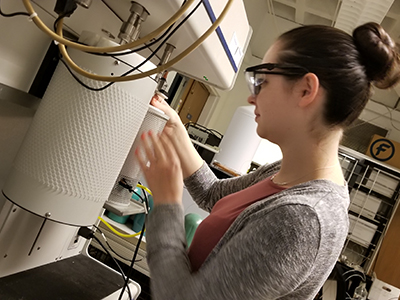Haley Morgan from Jamesville-DeWitt high school knows she wants to study engineering in college, possibly chemical engineering. This summer she will present her research on chemical reactions involving different metals—based on her work in Professor Jesse Bond’s lab
“I really like getting to design my own experiments and be able to create new ideas. To come here and see what you are doing and to realize—I really do like this and want to do this later in life,” says Morgan.
The summer research internship program for high school students was created thanks to a gift from Syracuse University alumni Tom McCausland ’64 and his wife, Linda, ’65.

Haley Morgan from Jamesville-DeWitt High School works in Prof. Jesse Bond’s lab.
In addition to lab work and presenting their research, interns have also had the opportunity to tour the Carrier Dome and get a behind-the-scenes look at the engineering skill required to keep the air-supported roof inflated.
Lagenberg believes the internship has prepared her to step into a higher education research environment—no matter which program she decides to major in.
“I feel like the people here are making a difference in science,” says Lagenberg. “I am getting experience I wouldn’t get elsewhere. I have thought about going into engineering and researching, and it is really cool to get a glimpse of that.”
For information on how you can support the High School Research Internship Program at the College of Engineering and Computer Science, click here.


